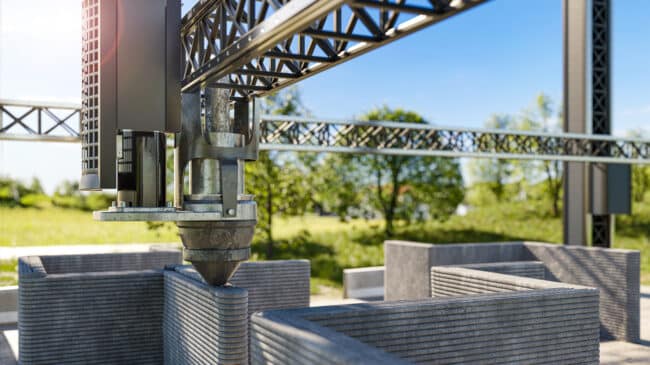Three-dimensional concrete printing (3DCP) is a promising home construction innovation. In light of the ongoing affordable housing crisis, 3D printing could prove a time- and cost-effective alternative to traditional construction for affordable housing. While this method has been successful when implemented, the primary boundary to expansion is an unclear legal framework.
Construction built through 3D printing uses a printer to stack thin layers of concrete, creating the skeleton of a home. This technology is derived from a process known as “contour crafting.” This process makes building intricate and curved shapes easier than traditional construction due to the maneuverability of the robotic arm which lays the concrete and the ability to give precise instructions. In addition to complex form construction, 3DCP has noticeable cost and time-saving benefits. One advantage is the reduction in labor.
Aside from the people needed to program the printer and to install finishes like plumbing and wiring, the printer does the bulk of the homebuilding. The resulting reduction in labor costs alone makes 3D printing an attractive option for developers.
A 2018 study by British and Malaysian engineers compared the cost of building a traditional home in the United Kingdom to that of a comparable 3D-printed home. Not accounting for the initial investment in a printer, these researchers estimated a 30% reduction in building costs per home.
Further, 3D printing as a construction method has substantial time-saving benefits. COBOD International is a company specializing in the use of 3D printing technology in construction. Evidence from COBOD suggests that 3D-printed homes can be built up to 20 times faster than traditional homes —critical at a time when a nationwide housing shortage has kept prices high.
While the cost- and time-reducing capabilities of 3D-printed construction are clear, there are questions about incorporating the technology into residential construction broadly. A 2018 study from California Polytechnic State University suggests that the size limitations of 3D construction and lack of aesthetic appeal will prove primary barriers to the broad acceptance of this new technology. Substantial progress has already been made on both fronts.
At the time of the study, most 3D-printed homes ranged between 600 and 900 square feet. The study attributes this size limitation to the cost of a printer large enough to construct more sizable structures and the consequent unaffordability of the homes produced. Understandably, the size constraint at the time of the study did not align with the needs of would-be homeowners in the United States, making 3D printing an undesirable construction tool for housing development.
Further, this study cites the exclusively concrete design and lack of customization options as potentially aesthetically off-putting to homebuyers. Innovative startups working on 3D construction have already put their efforts towards the development of better-looking and larger homes.
ICON, a 3D construction firm, in partnership with Lennar, is currently in the process of building a community, Wolf Ranch, of 100 3D-printed homes in Georgetown, Texas. As of July, 95 out of the 100 planned homes have been finished, and many have been sold and occupied. Once completed, this will be the largest community of 3D-printed houses in the world.
Counter to preliminary size concerns, these homes range between 1,850 and 3,000 square feet and have between three and four bedrooms–in line with the average size of an American home. ICON built Wolf Ranch using their original 3D printer, but they have since unveiled a new 3D printer that can construct two-story buildings up to 27 feet tall. Rapid advancements in printing capabilities have dispelled concerns about the size of homes.
The promise of affordability, however, has yet to fully manifest. Wolf Ranch homes have been sold for between $475,000 and $599,000. These prices are near the median home price in the Austin area. While not necessarily an overnight solution to bringing down housing prices, 3D-printed home construction is nevertheless a useful tool to bring timely and cost-effective additions to the supply of housing. Given that the housing affordability crisis is largely shortage-driven, further use of 3DCP will be necessary to fully realize its cost-saving potential–especially if traditional home dimensions and aesthetics are to be maintained.
Other developers have adopted 3D printing on a smaller scale–both in terms of quantity and the size of the houses themselves. Mighty Buildings in California, for example, has specialized in smaller homes that include accessory dwelling units (ADUs) and are nearly carbon-neutral. Currently, only 8% of 3D-printed homes in the United States are designed as ADUs, though the growing acceptance of ADUs in local zoning is likely to expand this use.
While acknowledging the lucrative nature of 3D-printed construction, the National Association of Homebuilders (NAHB) warns that there may be legal barriers to implementing this new technology:
“… [A]nyone interested in residential 3D printed construction should have the expectation that they will face heightened scrutiny from building and code officials, and will likely need to draft new contracts in order to capture the relationship nuances.”
One potential setback is the inconsistency of local building codes regarding 3D printing. An attempt to unify standards was incorporated into the International Residential Code, the comprehensive set of standards compiled by the International Code Council to regulate development. It is now up to municipalities to either adopt these recommendations or institute their own. Either way, legal clarity is a crucial step in incentivizing the use of 3DCP.
Further, because the technology is new and has ample room for error in the software, hardware, and printing elements, potential legal disputes could arise when mistakes are made involving parties not typically part of construction disputes. Construction contracts and liability rules must evolve to consider the responsibility of software companies and technology providers. A similar process is going on with liability in automated vehicles as part and parcel of these technological changes.
As affordable housing advocates and policymakers examine solutions to the current housing crisis, lowering barriers to the use of technological advancements should not be overlooked. Three-dimensional printing presents a cost- and time-effective alternative to traditional construction methods that can be used in conventional single-family home construction and ADUs. Now, the role of government should be to remove barriers and set clear standards.

